Plating with a lateral plate
1. Principles
Introduction
Articular fractures need anatomical reduction and fixation. They may be simple or comminuted and may be fixed with an anatomical plate.
The articular fragments are reduced and fixed first. In the second step, the extraarticular fracture component is reduced and fixed.
Noncomminuted fracture components, eg, between the articular fragments or between the articular block and the diaphysis, may be fixed with compression.
The reduction can be assisted with arthroscopy if skill and equipment are available.
In this procedure, the reduction and fixation of a comminuted articular fracture with a phalangeal head plate is shown.

Plate selection
Several plate types are available for treatment of this fracture:
- Phalangeal head plate; lateral
- T- or Y-plate; dorsal
- Condylar plate; dorsal or lateral
- Strut plate
Select a plate according to fragment size, fracture geometry, and surgeon’s preference.
A plate with variable-angle (VA) locking-head screws has the advantage of allowing insertion of two or three screws at variable angles into the articular block. The rounded plate edges avoid soft-tissue irritation and adhesion.

2. Patient preparation
Place the patient supine with the arm on a radiolucent hand table.

3. Approach
For this procedure, the following approach may be used:
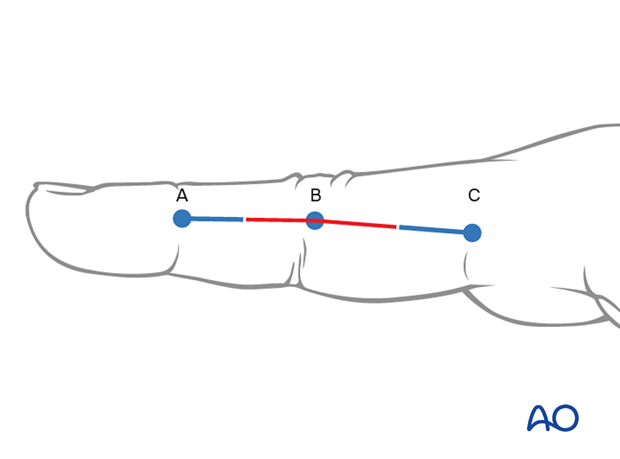
4. Reduction and fixation of the articular block in a simple T- and Y-shaped fracture
If the fracture line allows, eg, in a T- or Y-shaped fracture with the articular fracture line running from radial to ulnar, a lag screw may be inserted to stabilize the articular fracture. This converts a three-part fracture to a two-part fracture.
Make sure the screw track is not interfering with later plate application.
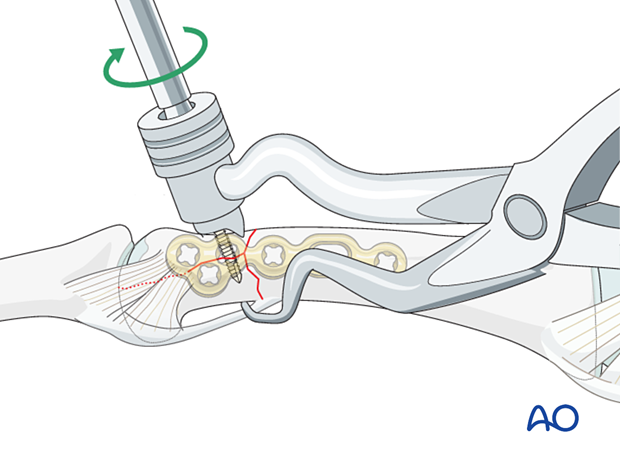
5. Reduction of a compression fracture
Compression fractures are not reducible by ligamentotaxis, as the centrally impacted fragments are devoid of soft-tissue attachments.
Direct reduction is, therefore, necessary.
The key to fixing compression fractures is restoring the joint surface to as close as normal as possible and supporting the reduction with bone graft and internal fixation.
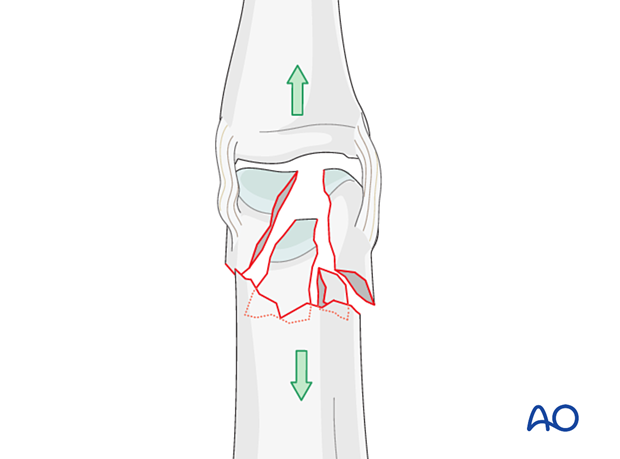
Use a K-wire, or dental pick, to disimpact the fragments and push towards the head of the metacarpal, which is used as a template to ensure congruity of the articular surface of the phalanx.
Since the metaphyseal cancellous bone is impacted, a void may be created by its disimpaction.
This jeopardizes the fracture in two ways:
- Very unstable situation in which the fragments may easily redisplace (collapse)
- Delayed healing process
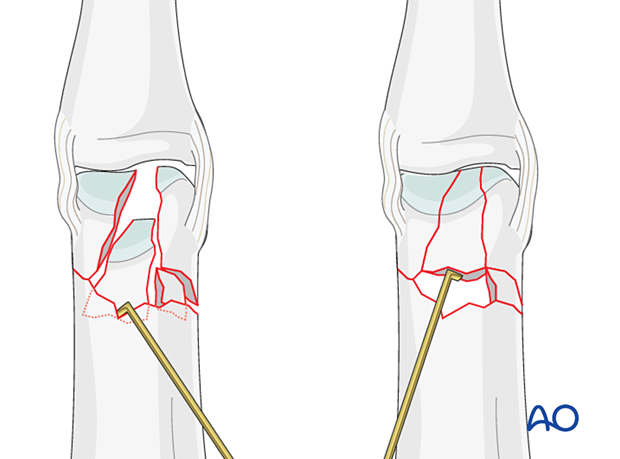
Buttressing small fragments
Additionally, a periarticular K-wire may be used to reposition and support impacted articular fragments.
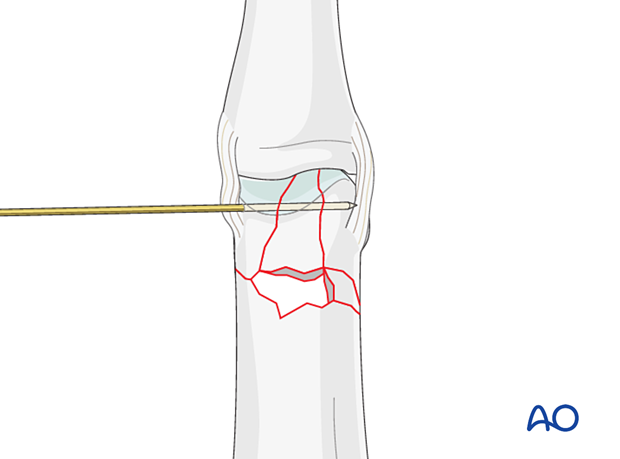
6. Checking alignment
Identifying malrotation
At this stage, it is advisable to check the alignment and rotational correction by moving the finger through a range of motion.
Rotational alignment can only be judged with flexed metacarpophalangeal (MCP) joints. The fingertips should all point to the scaphoid.
Malrotation may manifest by an overlap of the flexed finger over its neighbor. Subtle rotational malalignments can often be judged by a tilt of the leading edge of the fingernail when the fingers are viewed end-on.
If the patient is conscious and the regional anesthesia still allows active movement, the patient can be asked to extend and flex the finger.
Any malrotation is corrected by direct manipulation and later fixed.
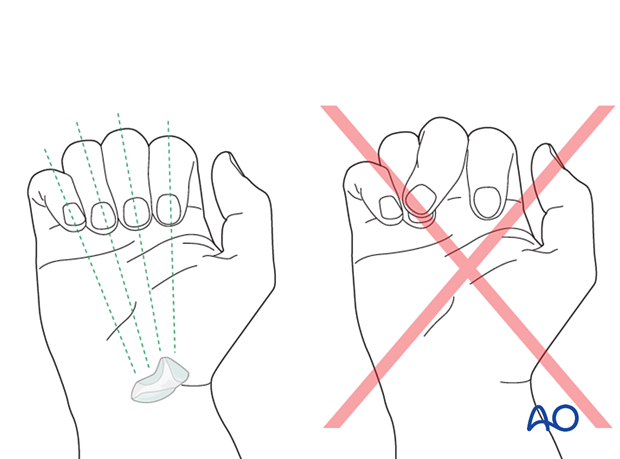
Using the tenodesis effect when under anesthesia
Under general anesthesia, the tenodesis effect is used, with the surgeon fully flexing the wrist to produce extension of the fingers and fully extending the wrist to cause flexion of the fingers.
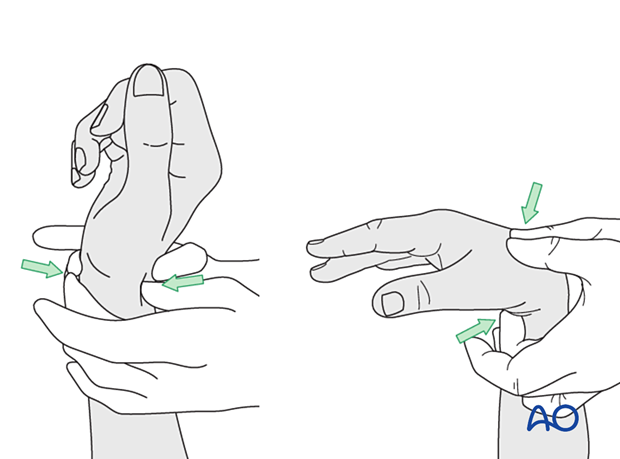
Alternatively, the surgeon can exert pressure against the muscle bellies of the proximal forearm to cause passive flexion of the fingers.
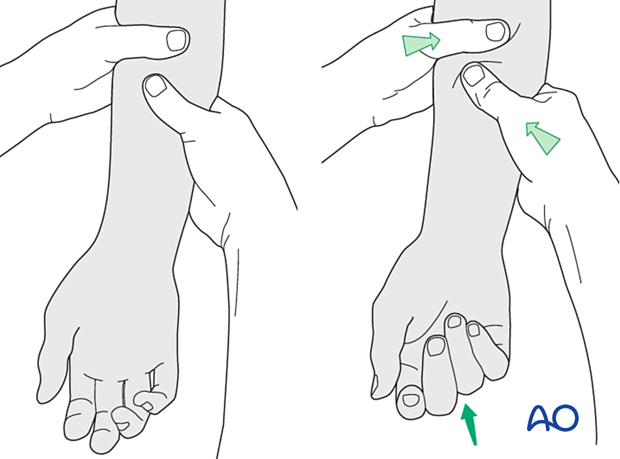
Confirm fracture fixation and stability with an image intensifier.
7. Bone graft addition
If conventional condylar plates are used, cancellous autograft, or very occasionally bone substitutes (eg, hydroxyapatite, tricalcium phosphate), will be necessary to support the articular fragments and fill the impaction void. Bone graft will enhance the healing process.
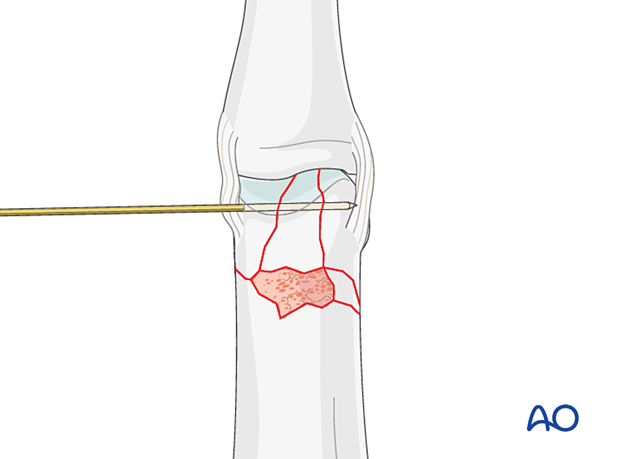
8. Plate preparation
Plate trimming
Adapt the plate length to fit the length of the proximal phalanx. Avoid sharp edges, which may be injurious to the tendons. There should be at least 3 plate holes proximal to the fracture available for fixation in the diaphysis. At least two screws need to be inserted into the diaphysis.
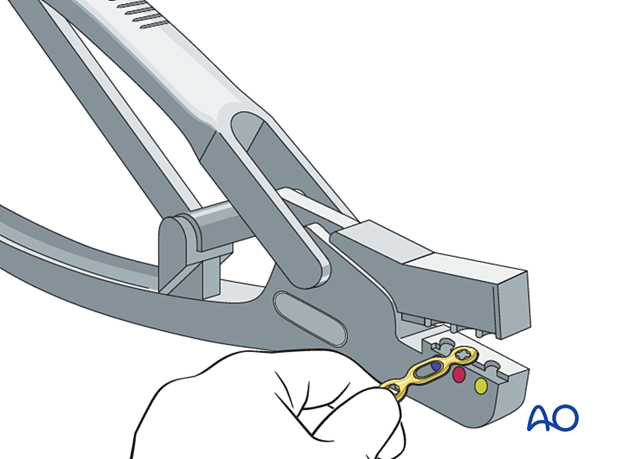
Bending and contouring for a T- or Y-shaped fracture
If the plate is perfectly adapted to the fit the lateral bone surface, tightening the screws may result in distraction of the metaphyseal fracture, creating a gap in the opposite cortex.
The plate is not contoured, so that it is “overbent” relative to the bone surface. When screws are tightened, compression is then applied across the whole fracture plane including the opposite cortex.
This may only be applied in fractures with large fragments, never in small-fragment comminution fractures, as the reduction may be compromised (collapse).
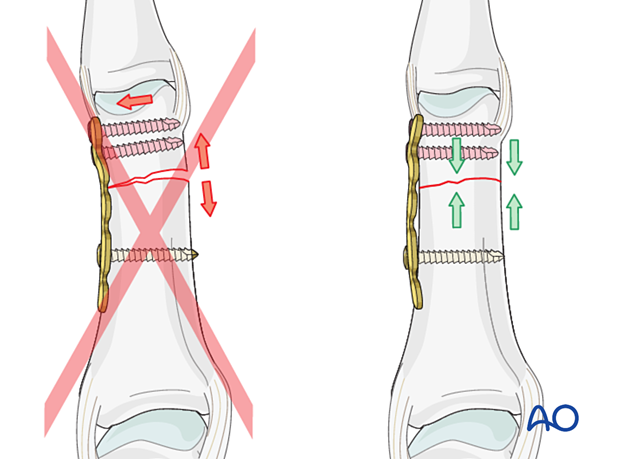
Bending and contouring for a comminuted fracture
In comminuted fractures, it is important to contour the plate to fit the bone perfectly. Neither compression nor distraction forces should occur through screw tightening, as the reduction would be compromised (collapse).
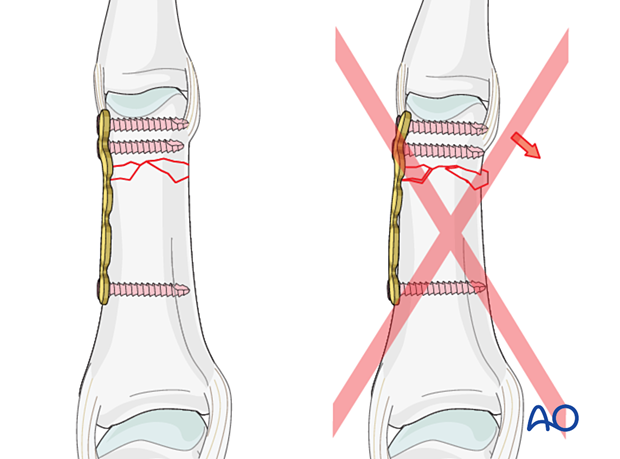
9. Plate fixation to the articular block
Plate positioning
Position the plate slightly dorsal to the midaxial line of the bone, allowing at least two screws in the distal fragment.
To avoid conflict with the insertion of the collateral ligament, a K-wire may be placed in the isometric insertion of the collateral ligament and the notch of the plate aligned to it.
Keep the plate in place with the atraumatic forceps.
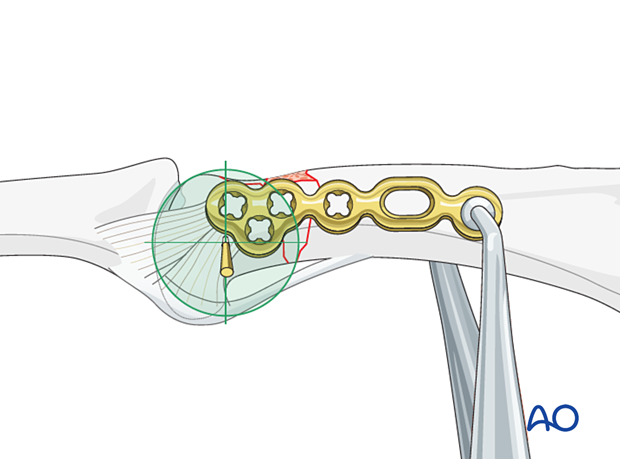
Screw insertion
Insert at least two VA locking head screws in the articular block.
In T- and Y-shaped fractures, extrinsic compression may be applied with forceps and maintained with the locking screws through the plate.
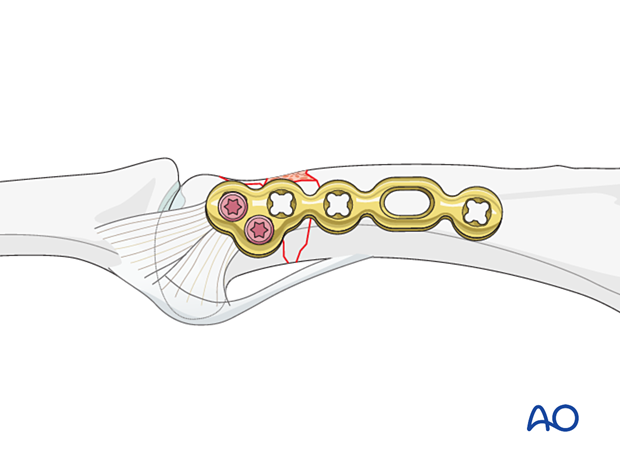
10. Bridge plating of a comminuted metadiaphyseal fracture
Correcting length and malrotation
Manipulate the distal part of the phalanx to correct length and malrotation.

Completion of screw insertion
Insert at least two screws into the most proximal plate holes.
Confirm length, alignment, and rotation.
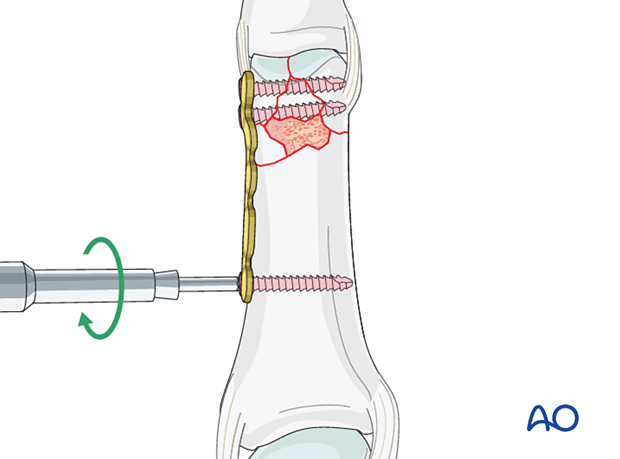
If the fracture configuration allows, insert further screws, but do not enter the comminuted zone.
Cover the plate with periosteum to avoid adhesion between the tendon and the implant leading to limited finger movement.

11. Compression plating of a simple metadiaphyseal fracture
Correcting length and malrotation
Manipulate the distal part of the phalanx to correct length and malrotation.
Screw insertion and compression
Insert a cortical screw in compression mode in the oblong hole.
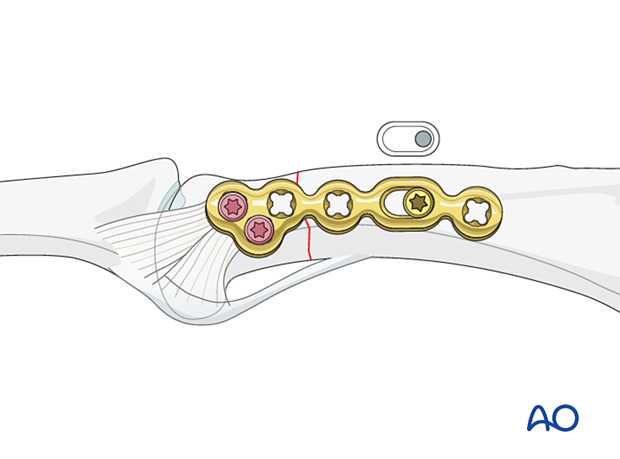
Prepare and insert a locking screw in the diaphysis.
Cover the plate with periosteum to avoid adhesion between the tendon and the implant leading to limited finger movement.
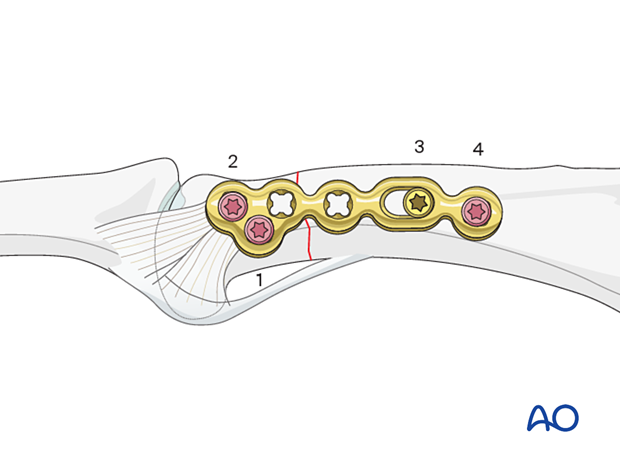
12. Final assessment
Confirm fracture reduction and stability and implant position with an image intensifier.
13. Aftercare
Postoperative phases
The aftercare can be divided into four phases of healing:
- Inflammatory phase (week 1–3)
- Early repair phase (week 4–6)
- Late repair and early tissue remodeling phase (week 7–12)
- Remodeling and reintegration phase (week 13 onwards)
Full details on each phase can be found here.
Postoperative treatment
If there is swelling, the hand is supported with a dorsal splint for a week. This would allow for finger movement and help with pain and edema control. The arm should be actively elevated to help reduce the swelling.
The hand should be splinted in an intrinsic plus (Edinburgh) position:
- Neutral wrist position or up to 15° extension
- MCP joint in 90° flexion
- PIP joint in extension
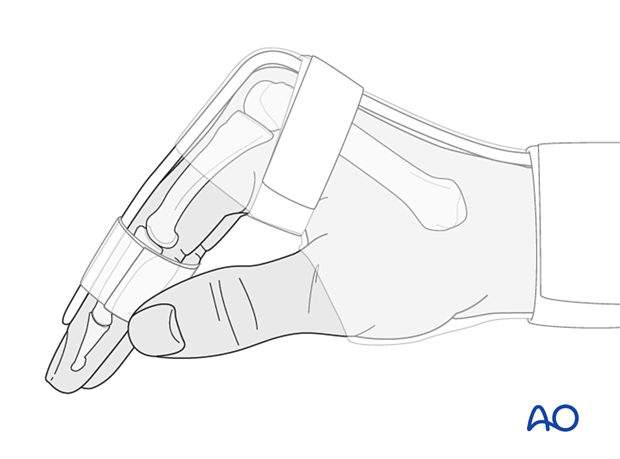
The reason for splinting the MCP joint in flexion is to maintain its collateral ligament at maximal length, avoiding scar contraction.
PIP joint extension in this position also maintains the length of the volar plate.
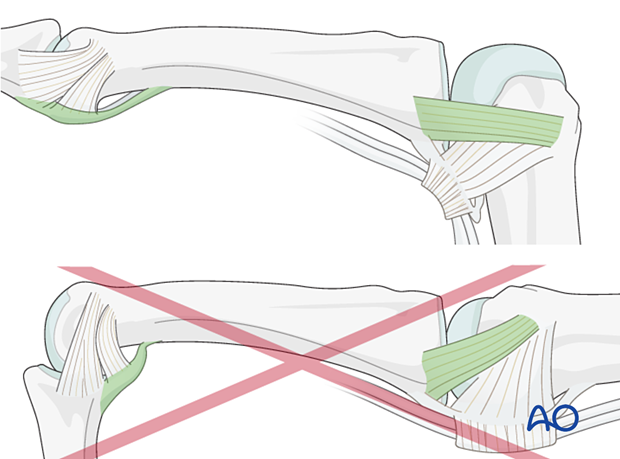
After subsided swelling, protect the digit with buddy strapping to a neighboring finger to neutralize lateral forces on the finger.
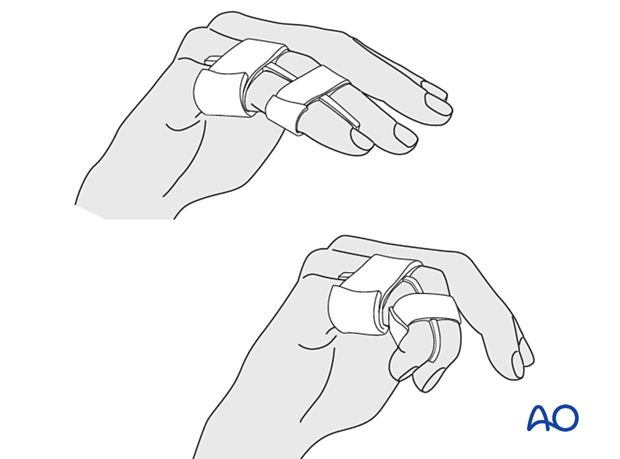
Functional exercises
To prevent joint stiffness, the patient should be instructed to begin active motion (flexion and extension) immediately after surgery.
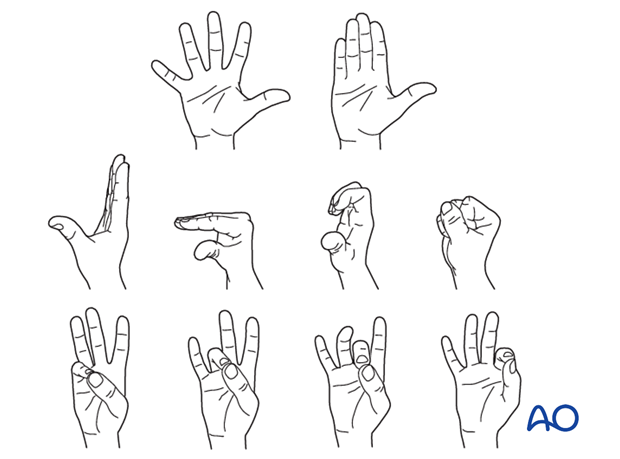
Follow-up
See the patient after 5 and 10 days of surgery.
Implant removal
The implants may need to be removed in cases of soft-tissue irritation.
In case of joint stiffness or tendon adhesion restricting finger movement, arthrolysis or tenolysis may become necessary. In these circumstances, the implants can be removed at the same time.













